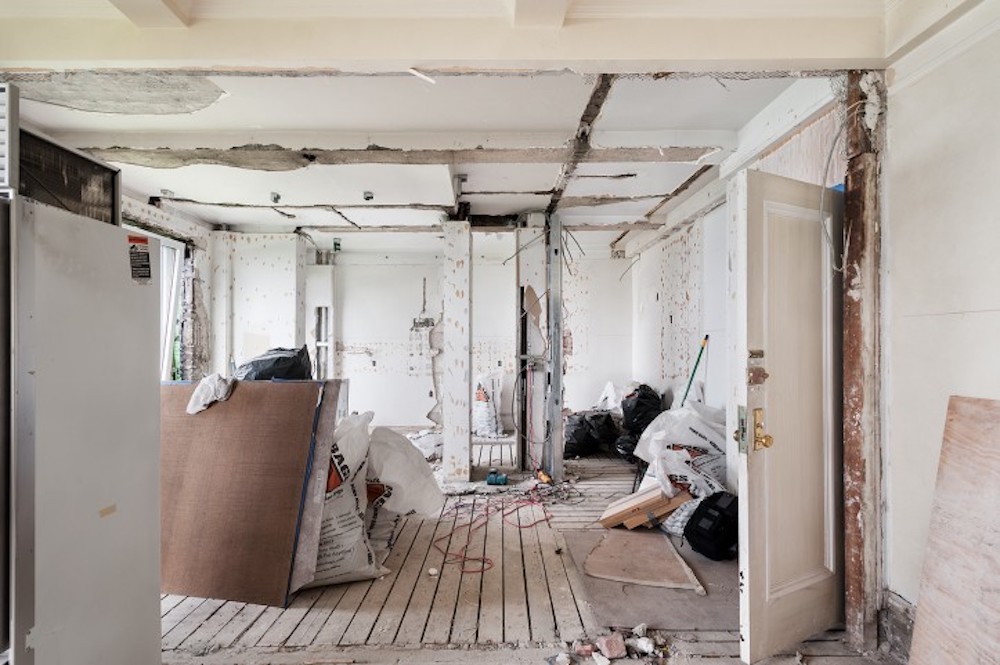Cost-Effective Ways to Prevent Foundation Damage
A solid foundation is the cornerstone of any home, but it can also be a significant source of stress and expense if it starts to deteriorate. Foundation damage can lead to costly repairs and even structural instability. Don’t let foundation problems ruin your home. Discover practical tips and strategies to safeguard your foundation and protect your investment.

At Sweeten, we’re experts at all things general contractors — we pre-screen them for our network, carefully select the best ones for your remodeling project, and work closely with hundreds of general contractors every day. So, we’ve tapped our internal expertise to bring you this guide. Sweeten brings homeowners an exceptional renovation experience by personally matching trusted general contractors to your project, while offering expert guidance and support—at no cost to you. Renovate expertly with Sweeten
Understanding foundation damage
Understanding foundation damage is essential for preventing costly repairs and ensuring the structural integrity of your home. Damage can occur because of a variety of factors—including:
- Soil erosion: When water flows away from the foundation, it can erode the soil, causing the foundation to settle unevenly. This can lead to cracks, uneven floors, and other problems.
- Water infiltration: Water can seep into the foundation through cracks or gaps, causing moisture damage and structural instability. This can lead to mold, mildew, and rot.
- Tree roots: Tree roots can exert pressure on the foundation as they grow, causing it to shift or crack. This can be a particular problem if trees are planted too close to the foundation.
- Poor drainage: Inadequate drainage can cause water to pool around the foundation, which can lead to erosion and damage. This can be exacerbated by heavy rainfall or snowmelt.
- Soil expansion and contraction: Changes in soil moisture content can cause the soil to expand and contract, putting stress on the foundation. This can be a particular problem in areas with extreme weather conditions.
- Seismic activity: Earthquakes can cause significant damage to foundations, especially in areas with high seismic activity.
- Construction defects: Poor construction practices or materials can lead to foundation problems over time. This can include using inadequate materials, not properly compacting the soil, or failing to install proper drainage.
It is important to be aware of the signs of foundation damage, so that you can address the problem before it becomes more serious. Some common signs of foundation damage include:
- Cracks: Cracks in the foundation walls or floors can be a sign of structural damage.
- Uneven floors: Uneven or sloping floors may indicate a foundation problem.
- Doors and windows that won’t close properly: Sticking or difficult-to-close doors and windows could be a sign of foundation settlement.
- Water pooling around the foundation: Water pooling around the foundation can suggest poor drainage or a leaking pipe.
- Mold or mildew growth: Mold and mildew growth can be a sign of water infiltration.
- Foundation settlement: Leaning walls or a tilting house can indicate foundation settlement.
Preventive measures
Exterior drainage:
- Proper grading: Create a gentle slope away from the foundation to divert rainwater. A slope of at least 6% is generally recommended. Use a laser level or a slope gauge to ensure proper grading of the drainage surrounding your home.
- Permeable pavers or gravel: These materials allow rainwater to infiltrate the ground, reducing the risk of erosion. Choose pavers with large gaps between them to allow for proper drainage.
- French drains: Install a perforated pipe surrounded by gravel to collect and channel rainwater away from the foundation. French drains are typically installed at the base of the foundation wall.
- Sump pumps: Use a sump pump to remove water that accumulates in a sump pit. Sump pumps are often used in areas with high groundwater levels or poor drainage.
Interior moisture control:
- Dehumidifiers: Use dehumidifiers to reduce humidity levels inside the home, especially in basements and crawl spaces. Excessive humidity can contribute to mold and mildew growth.
- Ventilation: Ensure proper ventilation in the home by opening windows and doors or using fans. Good ventilation helps to circulate air and reduce moisture buildup.
- Seal cracks and gaps: Caulk or seal any cracks or gaps in the foundation or walls to prevent water infiltration.
- Address leaks: Repair any leaks in plumbing pipes or the roof to prevent water damage.
Soil stabilization:
- Soil compaction: Use a tamper or vibratory roller to compact the soil around the foundation. This helps to prevent settlement and improve drainage.
- Retaining walls: Construct retaining walls to stabilize slopes and prevent soil erosion. Retaining walls can be made of various materials, such as masonry, wood, or metal.
- Hydro-sealing: Apply a waterproof coating to the foundation to prevent water infiltration. Hydro-sealing is effective in areas with high groundwater levels or poor soil conditions.
Tree care:
- Select appropriate tree species: Choose tree species that have shallow roots or are known for their non-invasive root systems.
- Proper pruning: Prune trees regularly to control their size and shape, and to prevent roots from growing towards the foundation.
- Root barriers: Install root barriers around the foundation to prevent tree roots from penetrating the soil beneath.
Regular inspections:
- Professional inspections: Schedule regular inspections by a qualified foundation contractor. Professional inspections can identify potential problems early on and prevent costly repairs.
- DIY checks: Conduct regular inspections of your foundation yourself. Look for signs of cracks, uneven floors, water pooling, or other abnormalities.
- Documentation: Keep a record of any foundation issues and repairs. This information can be helpful if you need to file an insurance claim or sell your home.
Cost-effective strategies
DIY vs. professional maintenance:
DIY:
- Advantages: Cost-effective, allows for greater control over the project.
- Disadvantages: Requires time, effort, and specialized skills.
Professional:
- Advantages: Ensures quality workmanship, saves time and effort, mitigates risks of further damage, provides expert diagnosis and recommendations, offers warranties and guarantees.
- Disadvantages: Can be more expensive, less control over the project.
Factors to consider:
- Severity of damage: Minor issues can often be addressed DIY, while major problems may require professional expertise. For example, small cracks in the foundation can often be repaired with a sealant, but more extensive damage, such as bowing walls or foundation settlement, may require professional intervention.
- Skill level: If you have experience with home repairs, you may be able to handle some foundation maintenance tasks. However, more complex repairs, such as underpinning or installing piers, require specialized knowledge and skills.
- Time constraints: DIY projects can be time-consuming, especially if you have limited experience. If you are short on time or prefer to focus on other tasks, hiring a professional may be the best option.
- Budget: Professional services can be more expensive, but they may also be more cost-effective in the long run if they prevent major damage. In some cases, DIY repairs can lead to further damage if not done correctly, resulting in higher costs in the long run.
Prioritizing repairs:
- Evaluate the severity of damage: Determine if the foundation damage is causing immediate safety concerns or affecting the structural integrity of the home.
- Consider the potential consequences of delaying repairs: Ignoring foundation problems can lead to more extensive damage and higher repair costs in the future. For example, a small crack in the foundation could eventually lead to water infiltration, mold growth, and structural instability.
- Prioritize repairs based on urgency and cost-effectiveness: Address urgent issues first, such as those that pose a safety risk. Then, focus on repairs that are necessary to prevent further damage or improve the functionality of the home. For example, if the foundation is settling and causing doors and windows to stick, this should be addressed promptly to prevent further damage and ensure the safety of the home.
Long-term planning:
- Create a foundation maintenance budget: Allocate funds for regular inspections, minor repairs, and potential major repairs.
- Track expenses: Keep records of all foundation-related costs to monitor your spending and identify areas for savings.
- Consider insurance coverage: Explore insurance options that cover foundation damage, such as homeowners insurance with additional coverage for foundation repairs.
- Develop a maintenance schedule: Set a schedule for regular inspections and preventative maintenance to catch potential problems early on.
Hiring professionals and general contractors
- Research and compare: Research different foundation contractors or general contractors in your area and compare their qualifications, experience, and pricing.
- Get multiple quotes: Obtain quotes from several contractors to ensure you are getting a fair price.
- Check references: Ask for references from previous clients and verify their satisfaction with the contractor’s work.
- Verify licensing and insurance: Make sure the contractor is licensed and insured to protect yourself in case of any issues.
- Communicate clearly: Clearly communicate your expectations and budget to the contractor to avoid misunderstandings.
- Get everything in writing: Have a written contract that outlines the scope of work, materials, timeline, and payment terms.
Materials:
Foundation repair materials can vary depending on the type of damage and the recommended repair method. Common materials used in foundation repair include:
- Concrete: Used for underpinning, slabjacking, and other repair methods.
- Steel: Used for reinforcing the foundation and preventing further settlement.
- Wood: Used for temporary shoring or bracing during repairs.
- Geotextiles: Used to filter and stabilize soil around the foundation.
- Hydraulic jacks: Used to lift and level the foundation during slabjacking or underpinning.
- Helical piers: Used to stabilize the foundation by transferring load to deeper, more stable soil layers.
Protect your home’s foundation and enjoy peace of mind. By understanding the causes of foundation damage and taking proactive steps to prevent it, you can significantly reduce the risk of costly repairs. Remember, prevention is key. Invest in regular inspections, address potential issues promptly, and implement effective preventive measures to safeguard your home’s foundation for years to come.
Ready to get started?
Post your project on Sweeten for free and make your dream home a reality. Sweeten puts you in control of your renovation, from finding the perfect contractor and gathering design inspiration, to using cost guides to plan your budget wisely.










